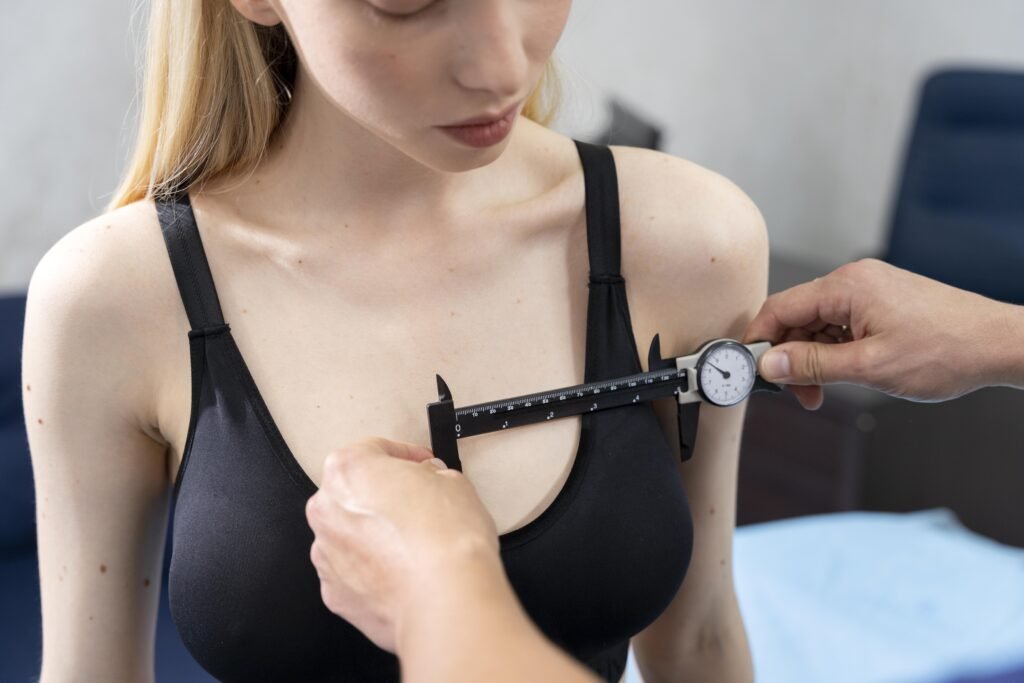

Breast enlargement is often necessary to address cosmetic flaws that have developed. It usually involves placing silicone implants for breast augmentation. These products are completely safe for health, as confirmed by numerous scientific studies. We use structured implants with a textured surface to facilitate tissue growth. In addition to a wide range of different sizes, there are round and teardrop-shaped (anatomical) implants available with varying projection strengths.
Breast lift surgery involves tightening the skin and surrounding tissues of the breast muscles, improving the natural shape of the breast, and addressing sagging and drooping. While both procedures can be classified as breast augmentation surgeries, each has unique characteristics in terms of how they are performed, what is being addressed, and how the results appear.

Breast cosmetic surgery comprises a set of cosmetic surgical techniques aimed at changing the size or shape of the breast, eliminating existing flaws, and making the breast more attractive. Breast augmentation and breast lifting are performed in cases of breast sagging. The causes of breast sagging may vary, but for a harmonious and attractive breast, surgical correction is required. If there is a desire to enhance and shape the sagging breast more aesthetically, a breast lifting should be performed in addition to breast augmentation. This is a generally recommended scientific approach.
Currently, breast lifting surgery is widely sought after as a surgical solution to correct breast shape. This procedure is primarily performed on young mothers who have recently finished breastfeeding and older women whose breasts have lost their beauty and elasticity due to age-related changes.
For these patients, breast lift surgery is necessary. With breast lift and tightening, you can effectively and quickly achieve the following results:
The main goal of breast lifting techniques is to reshape sagging breasts without significantly affecting their volume, which typically decreases in the upper part of the breast and upper chest area.
Sometimes, to restore an attractive breast shape, silicone implants are not required at all; simply lifting the breasts is sufficient. Breast lifting surgery is fully justified when it is necessary to correct the breast shape or restore its firmness without changing the size. In cases where additional glandular augmentation or restoration of the previous size is needed, breast augmentation and breast lifting can be combined using silicone implants.
Individuals who have severe scarring, negative reactions to surgery or allergies, extremely delicate skin prone to excessive bleeding, and so on, are not suitable for silicone breast augmentation.
Breast augmentation with silicone is prohibited if there is inflammation or a tumor in the breast area, or if there is decay, atrophy, or an imminent source of infection in the skin.
Individuals who suffer from psychosis or have various diseases, psychological concerns about breast augmentation, long-term abnormal blood clotting function, and so on are prohibited from choosing silicone breast augmentation.
Mothers who breastfeed their children before surgery can continue to breastfeed after the procedure. Since the silicone implant is placed beneath the breast tissue, the breast itself has no connection to the milk ducts, and the milk ducts are not harmed, nor is the nerve tissue affected. In other words, there is no direct link between the implants and the mammary glands.
After breast augmentation surgery, avoid excessive force, bending, and lifting heavy objects during the early postoperative period, as these activities can cause increased swelling and even bleeding. When sleeping, it is recommended to lie on your back to avoid pressure on your breasts.
Remove all drainage tapes after one or two days following the surgery, and the dressing can also be replaced or removed at this time. You may need to wear a supportive bra for several weeks until swelling and bruising in the breasts subside. Starting from one week after the surgery, gradually remove the sutures within two weeks.
Sensory disturbances in the areola and nipple are rare and usually temporary. The breast also requires time to return to its natural shape. Redness at the incision site may persist for several months in the early postoperative period.
Silicone breast augmentation surgery is a highly important procedure, where the implants are generally placed above the main chest muscle and do not have any impact on the nipple or breast tissue. Breast augmentation with silicone implants will not affect mammography results, and the synthetic material can maintain its effect on the body throughout one’s lifetime without removal.
Silicone implants have undergone extensive long-term safety reviews conducted by the U.S. Food and Drug Administration (FDA) & Dubai Health Authority (DHA) for human use, confirming that silicone implants are not harmful to the human body. Therefore, is silicone breast augmentation safe? The answer is yes, it is very safe.
One common question we receive regarding silicone breast implants is whether they can rupture or tear. The idea of a silicone breast implant bursting or tearing is a common misconception. The implant shells are filled with cohesive gel, which means that the silicone implants can’t explode or rupture. However, it is important to consult with your plastic surgeon and obtain support for the appropriate treatment options for you.

UAE also embodies the essence of self compassion and self care that is part of Bellaroma message to the world.